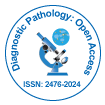Molecular analysis of spinal nerve sheath tumors has identified CSH1 as a candidate gene for differentiating between Schwannomatosis and Spinal schwannoma
Received Date: Mar 25, 2025 / Accepted Date: Apr 24, 2025 / Published Date: Apr 24, 2025
Abstract
Purpose: The most common form of schwannomatosis is defined by the presence of multiple and recurrent spinal schwannomas, which exhibit symptoms resembling those of spinal schwannomas. The molecular mechanisms responsible for tumor multiplicity in schwannomatosis remain poorly understood. This study aims to identify Differentially Expressed Genes (DEGs) between intradural spinal schwannomas and schwannomatosis and to explore the underlying mechanisms of schwannomatosis pathogenesis.
Methods: We utilized high-throughput sequencing technology to analyze 30 tumor samples (15 conventional spinal schwannomas and 15 schwannomatosis cases). Differentially expressed genes between the two groups were identified using the limma R package. Machine learning algorithms were applied to extract significant biomarkers from the DEGs. The diagnostic value of these biomarkers for schwannomatosis was assessed using Receiver Operating Characteristic (ROC) curve analysis and an alignment diagram. Gene Set Enrichment Analysis (GSEA) was employed to identify relevant biological pathways.
Results: Our analysis identified 249 DEGs, with OXTR, CSH1, SNCAIP and DPP4 emerging as key candidate genes. Subsequent q-PCR experiments confirmed the reliability of these biomarkers. Validation demonstrated that CSH1 expression was elevated in schwannomatosis samples, whereas DPP4, OXTR and SNCAIP expression levels were decreased compared to solitary schwannoma cells. ROC curve analysis and the Alignment Diagram supported the stability and accuracy of our diagnostic model. GO functional annotation and KEGG pathway enrichment analysis suggested that these DEGs are involved in biological processes related to immunity, inflammation regulation and tumorigenesis.
Conclusion: We developed a novel diagnostic model for distinguishing between schwannomatosis and spinal schwannomas. These transcriptional changes deepen our understanding of schwannomatosis pathogenesis, identify key risk factors and offer valuable insights into potential therapeutic targets.
Keywords: Spinal tumors; Schwannomatosis; Transcriptomics; Regulatory network; Genomics
Citation: Shi G, Ren H, Zhao D, Zhao Q, Chen H, et al. (2025) Molecular Analysis of Spinal Nerve Sheath Tumors has Identified CSH1 as a Candidate Gene for Differentiating between Schwannomatosis and Spinal schwannoma. Diagnos Pathol Open 10:247.
Copyright: © 2025 Shi G, Ren H, Zhao D, Zhao Q, Chen H, et al. This is an openaccess article distributed under the terms of the Creative Commons Attribution License, which permits unrestricted use, distribution and reproduction in any medium, provided the original author and source are credited.
Select your language of interest to view the total content in your interested language
Share This Article
Open Access Journals
Article Usage
- Total views: 937
- [From(publication date): 0-0 - Dec 19, 2025]
- Breakdown by view type
- HTML page views: 793
- PDF downloads: 144
